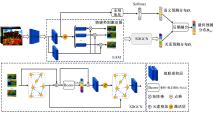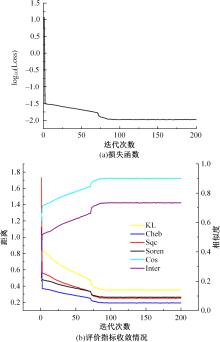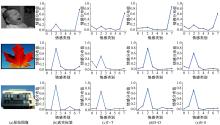Journal of Jilin University(Engineering and Technology Edition) ›› 2023, Vol. 53 ›› Issue (9): 2601-2610.doi: 10.13229/j.cnki.jdxbgxb.20211169
Previous Articles Next Articles
Dynamic graph convolutional neural network for image sentiment distribution prediction
Yu-ting SU1,2( ),Ji WANG2,Wei ZHAO1,Pei-guang JING1,2(
),Ji WANG2,Wei ZHAO1,Pei-guang JING1,2( )
)
- 1.School of Electrical and Information Engineering,Tianjin University,Tianjin 300072,China
2.Tianjin International Engineering Institute,Tianjin University,Tianjin 300072,China
CLC Number:
- TP391
| 1 | Zhou L, Fan X, Ma Y, et al. Uncertainty-aware cross-dataset facial expression recognition via regularized conditional alignment[C]∥Proceedings of ACM International Conference on Multimedia, New York, USA, 2020: 2964-2972. |
| 2 | Farzaneh A H, Qi X. Discriminant distribution-agnostic loss for facial expression recognition in the wild[C]∥Proceedings of the IEEE Conference on Computer Vision and Pattern Recognition Workshops, Piscataway, USA, 2020: 406-407. |
| 3 | 卢洋, 王世刚, 赵文婷, 等. 基于离散Shearlet类别可分性测度的人脸表情识别方法[J].吉林大学学报: 工学版, 2019, 49(5): 1715-1725. |
| Lu Yang, Wang Shi-gang, Zhao Wen-ting, et al. Facial expression recognition based on separability assessment of discrete Shearlet transform[J]. Journal of Jilin University (Engineering and Technology Edition), 2019, 49(5): 1715-1725. | |
| 4 | 方明, 陈文强. 结合残差网络及目标掩膜的人脸微表情识别[J].吉林大学学报: 工学版, 2021, 51(1): 303-313. |
| Fang Ming, Chen Wen-qiang. Face micro-expression recognition based on ResNet with object mask[J]. Journal of Jilin University (Engineering and Technology Edition), 2021, 51(1): 303-313. | |
| 5 | Huang F, Wei K, Weng J, et al. Attention-based modality-gated networks for image-text sentiment analysis[J]. ACM Transactions on Multimedia Computing, Communications, and Applications, 2020, 16(3): 1-19. |
| 6 | Ji R, Chen F, Cao L, et al. Cross-modality microblog sentiment prediction via bi-layer multimodal hypergraph learning[J]. IEEE Transactions on Multimedia, 2018, 21(4): 1062-1075. |
| 7 | Jian M, Dong J, Gong M, et al. Learning the traditional art of Chinese calligraphy via three-dimensional reconstruction and assessment[J]. IEEE Transactions on Multimedia, 2019, 22(4): 970-979. |
| 8 | Yang J, She D, Lai Y K, et al. Retrieving and classifying affective images via deep metric learning[C]∥Proceedings of the AAAI Conference on Artificial Intelligence, Palo Alto, USA, 2018: 491-498. |
| 9 | Yao X, She D, Zhao S, et al. Attention-aware polarity sensitive embedding for affective image retrieval[C]∥Proceedings of the IEEE International Conference on Computer Vision. Piscataway, USA, 2019: 1140-1150. |
| 10 | Li Z, Liu J, Zhu X, et al. Image annotation using multi-correlation probabilistic matrix factorization[C]∥Proceedings of the ACM International Conference on Multimedia, New York, USA, 2010: 1187-1190. |
| 11 | Li Z, Tang J, He X. Robust structured nonnegative matrix factorization for image representation[J]. IEEE Transactions on Neural Networks and Learning Systems, 2017, 29(5): 1947-1960. |
| 12 | Yang X, Song X, Feng F, et al. Attribute-wise explainable fashion compatibility modeling[J]. ACM Transactions on Multimedia Computing, Communications, and Applications, 2021, 17(1): 1-21. |
| 13 | Yang X, Song X, Han X, et al. Generative attribute manipulation scheme for flexible fashion search[C]∥Proceedings of the 43rd International ACM SIGIR Conference on Research and Development in Information Retrieval, New York, USA, 2020: 941-950. |
| 14 | Geng X. Label distribution learning[J]. IEEE Transactions on Knowledge and Data Engineering, 2016, 28(7): 1734-1748. |
| 15 | Peng K C, Chen T, Sadovnik A, et al. A mixed bag of emotions: model, predict, and transfer emotion distributions[C]∥Proceedings of the IEEE Conference on Computer Vision and Pattern Recognition, Piscataway, USA, 2015: 860-868. |
| 16 | Geng X, Yin C, Zhou Z H. Facial age estimation by learning from label distributions[J]. IEEE Transactions on Pattern Analysis and Machine Intelligence, 2013, 35(10): 2401-2412. |
| 17 | Yang J, Sun M, Sun X. Label distribution learning via augmented conditional probability neural network[C]∥Proceedings of the AAAI Conference on Artificial Intelligence, Palo Alto, USA, 2017: 224-230. |
| 18 | Zhou Y, Xue H, Geng X. Emotion distribution recognition from facial expressions[C]∥Proceedings of the ACM International Conference on Multimedia, New York, USA, 2015: 1247-1250. |
| 19 | Ren T, Jia X, Li W, et al. Label distribution learning with label-specific features[C]∥Proceedings of the International Joint Conference on Artificial Intelligence, San Mateo, USA, 2019: 3318-3324. |
| 20 | Zhao S, Yao H, Gao Y, et al. Continuous probability distribution prediction of image emotions via multitask shared sparse regression[J]. IEEE Transactions on Multimedia, 2016, 19(3): 632-645. |
| 21 | Plutchik R. Emotions: a general psychoevolutionary theory[J]. Approaches to Emotion, 1984(1984): 197-219. |
| 22 | Xu M, Zhou Z H. Incomplete label distribution learning[C]∥Proceedings of the International Joint Conference on artificial intelligence, San Mateo, USA, 2017: 3175-3181. |
| 23 | Jia X, Li Z, Zheng X, et al. Label distribution learning with label correlations on local samples[J]. IEEE Transactions on Knowledge and Data Engineering, 2019, 33(4): 1619-1631. |
| 24 | Jia X, Zheng X, Li W, et al. Facial emotion distribution learning by exploiting low-rank label correlations locally[C]∥Proceedings of the IEEE/CVF Conference on Computer Vision and Pattern Recognition, Piscataway, USA, 2019: 9841-9850. |
| 25 | Chen T, Yu F X, Chen J, et al. Object-based visual sentiment concept analysis and application[C]∥Proceedings of the ACM International Conference on Multimedia, New York, USA, 2014: 367-376. |
| 26 | Su Y T, Zhao W, Jing P G, et al. Exploiting low-rank latent gaussian graphical model estimation for visual sentiment distribution[J]. IEEE Transactions on Multimedia, 2022,25: 1243-1255. |
| 27 | 缪裕青, 雷庆庆, 张万桢, 等. 多视觉目标融合的图像情感分析研究[J]. 计算机应用研究, 2021, 38(4): 1250-1255. |
| Miao Yu-qing, Lei Qing-qing, Zhang Wan-zhen, et al. Research on image sentiment analysis based on multi-visual object fusion[J] Application Research of Computers, 2021, 38(4): 1250-1255. | |
| 28 | 盛家川, 陈雅琦, 王君, 等. 深度学习结构优化的图像情感分类[J]. 红外与激光工程, 2020, 49(11): 264-273. |
| Sheng Jia-chuan, Chen Ya-qi, Wang Jun, et al. Image sentiment classification via deep learning structure optimization[J] Infrared and Laser Engineering, 2020, 49(11): 264-273. | |
| 29 | Chen T, Borth D, Darrell T, et al. Deepsentibank: visual sentiment concept classification with deep convolutional neural networks[J/OL]. [2021-10-25]. |
| 30 | Zhu X, Li L, Zhang W, et al. Dependency exploitation: a unified CNN-RNN approach for visual emotion recognition[C]∥Proceedings of the International Joint Conference on Artificial Intelligence, San Mateo, USA, 2017: 3595-3601. |
| 31 | Campos V, Salvador A, Giró-i-Nieto X, et al. Diving deep into sentiment: understanding fine-tuned CNNs for visual sentiment prediction[C]∥Proceedings of the 1st International Workshop on Affect & Sentiment in Multimedia, New York, USA, 2015: 57-62. |
| 32 | Campos V, Jou B, Giro-i-Nieto X. From pixels to sentiment: fine-tuning CNNs for visual sentiment prediction[J]. Image and Vision Computing, 2017, 65(1): 15-22. |
| 33 | You Q, Luo J, Jin H, et al. Robust image sentiment analysis using progressively trained and domain transferred deep networks[C]∥Proceedings of the AAAI Conference on Artificial Intelligence, Palo Alto, USA, 2015: 381-388. |
| 34 | Yang J, She D, Sun M. Joint image emotion classification and distribution learning via deep convolutional neural network[C]∥Proceedings of the International Joint Conference on Artificial Intelligence, San Mateo, USA, 2017: 3266-3272. |
| 35 | 徐冰冰, 岑科廷, 黄俊杰, 等. 图卷积神经网络综述[J].计算机学报, 2020, 43(5): 755-780. |
| Xu Bing-bing, Cen Ke-yan, Huang Jun-jie, et al. A survey on graph convolutional neural network[J] Chinese Journal of Computers, 2020, 43(5): 755-780. | |
| 36 | Chen T, Xu M, Hui X, et al. Learning semantic-specific graph representation for multi-label image recognition[C]∥Proceedings of the IEEE/CVF International Conference on Computer Vision, Piscataway, USA, 2019: 522-531. |
| 37 | He T, Jin X. Image emotion distribution learning with graph convolutional networks[C]∥Proceedings of the International Conference on Multimedia Retrieval, New York, USA, 2019: 382-390. |
| 38 | Zhou B, Khosla A, Lapedriza A, et al. Learning deep features for discriminative localization[C]∥Proceedings of the IEEE Conference on Computer Vision and Pattern Recognition, Los Alamitos, USA, 2016: 2921-2929. |
| 39 | Yang J, Sun M, Sun X. Label distribution learning via augmented conditional probability neural network[C]∥Proceedings of the AAAI Conference on Artificial Intelligence, Palo Alto, USA, 2017: 224-230. |
| 40 | Peng K C, Chen T, Sadovnik A, et al. A mixed bag of emotions: model, predict, and transfer emotion distributions[C]∥Proceedings of the IEEE Conference on Computer Vision and Pattern Recognition, Piscataway, USA, 2015: 860-868. |
| 41 | Jia X, Li W, Liu J, et al. Label distribution learning by exploiting label correlations[C]∥Proceedings of the AAAI Conference on Artificial Intelligence, Palo Alto, USA, 2018: 3310-3317. |
| 42 | Xiong H, Liu H, Zhong B, et al. Structured and sparse annotations for image emotion distribution learning[C]∥Proceedings of the AAAI Conference on Artificial Intelligence, Palo Alto, USA, 2019: 363-370. |
| [1] | Mian-shu CHEN,Lu-lu YU,Xiao-ni LI,Hong-yu ZHENG. Loop detection based on uniform ORB [J]. Journal of Jilin University(Engineering and Technology Edition), 2023, 53(9): 2666-2675. |
| [2] | Qiang GUO,Guo-hui ZHU,Wan-chen LI. TDOA/FDOA localization based on chaotic sparrow search algorithm [J]. Journal of Jilin University(Engineering and Technology Edition), 2023, 53(2): 593-600. |
| [3] | Hou⁃jie LI,Fa⁃sheng WANG,Jian⁃jun HE,Yu ZHOU,Wei LI,Yu⁃xuan DOU. Pseudo sample regularization Faster R⁃CNN for traffic sign detection [J]. Journal of Jilin University(Engineering and Technology Edition), 2021, 51(4): 1251-1260. |
| [4] | Hua-wei JIANG,Zhen YANG,Xin ZHANG,Qian-lin DONG. Research progress of image dehazing algorithms [J]. Journal of Jilin University(Engineering and Technology Edition), 2021, 51(4): 1169-1181. |
| [5] | De-xing WANG,Ruo-you WU,Hong-chun YUAN,Peng GONG,Yue WANG. Underwater image restoration based on multi-scale attention fusion and convolutional neural network [J]. Journal of Jilin University(Engineering and Technology Edition), 2021, 51(4): 1396-1404. |
| [6] | Jing JIN,Jian-wu DANG,Yang-ping WANG,Dong SHEN. Multi⁃cue particle filter tracking based on fuzzy statistical texture features [J]. Journal of Jilin University(Engineering and Technology Edition), 2021, 51(3): 1111-1120. |
| [7] | Guo-hua LIU,Wen-bin ZHOU. Pulse wave signal classification algorithm based on time⁃frequency domain feature aliasing using convolutional neural network [J]. Journal of Jilin University(Engineering and Technology Edition), 2020, 50(5): 1818-1825. |
| [8] | Ke-yan WANG,Di WANG,Xi ZHAO,Jing-yi CHEN,Yun-song LI. Image dehazing based on joint estimation via convolutional neural network [J]. Journal of Jilin University(Engineering and Technology Edition), 2020, 50(5): 1771-1777. |
| [9] | Zai-feng SHI,Jin-zhuo LI,Qing-jie CAO,Hui-long LI,Qi-xing HU. Low⁃dose spectral computer⁃tomography imaging denoising method via a generative adversarial network [J]. Journal of Jilin University(Engineering and Technology Edition), 2020, 50(5): 1755-1764. |
| [10] | Hua CHEN,Wei GUO,Jing-wen YAN,Wen-hao ZHUO,Liang-bin WU. A new deep learning method for roads recognition from SAR images [J]. Journal of Jilin University(Engineering and Technology Edition), 2020, 50(5): 1778-1787. |
| [11] | Wei ZHANG,Yong HAN,Ming JIN,Xiao-lin QIAO. Toeplitz matrices reconstruction based DOA estimation for coherent signals [J]. Journal of Jilin University(Engineering and Technology Edition), 2020, 50(2): 703-710. |
| [12] | Yan-fen CHENG,Li-juan YAO,Qiao YUAN,Xian-qiao CHEN. Clearing strategy of underwater video image [J]. Journal of Jilin University(Engineering and Technology Edition), 2020, 50(2): 668-677. |
| [13] | Xiao-hui YU,Zhi-cheng ZHANG,Xin-bo LI,Xiao-dong SUN. Parameter estimation of exponentially damped sinusoidsbased on state⁃space model [J]. Journal of Jilin University(Engineering and Technology Edition), 2019, 49(6): 2083-2088. |
| [14] | Fu LIU, Mei-jing QUAN, Ke WANG, Yun LIU, Bing KANG, Zhi-wu HAN, Tao HOU. Indoor positioning method based on location fingerprinting of imitating mechanism of scorpion vibration source [J]. Journal of Jilin University(Engineering and Technology Edition), 2019, 49(6): 2076-2082. |
| [15] | Zi-ji MA,Hao LU,Yan-ru DONG. Dual path convolutional neural network forsingle image super⁃resolution [J]. Journal of Jilin University(Engineering and Technology Edition), 2019, 49(6): 2089-2097. |
|





